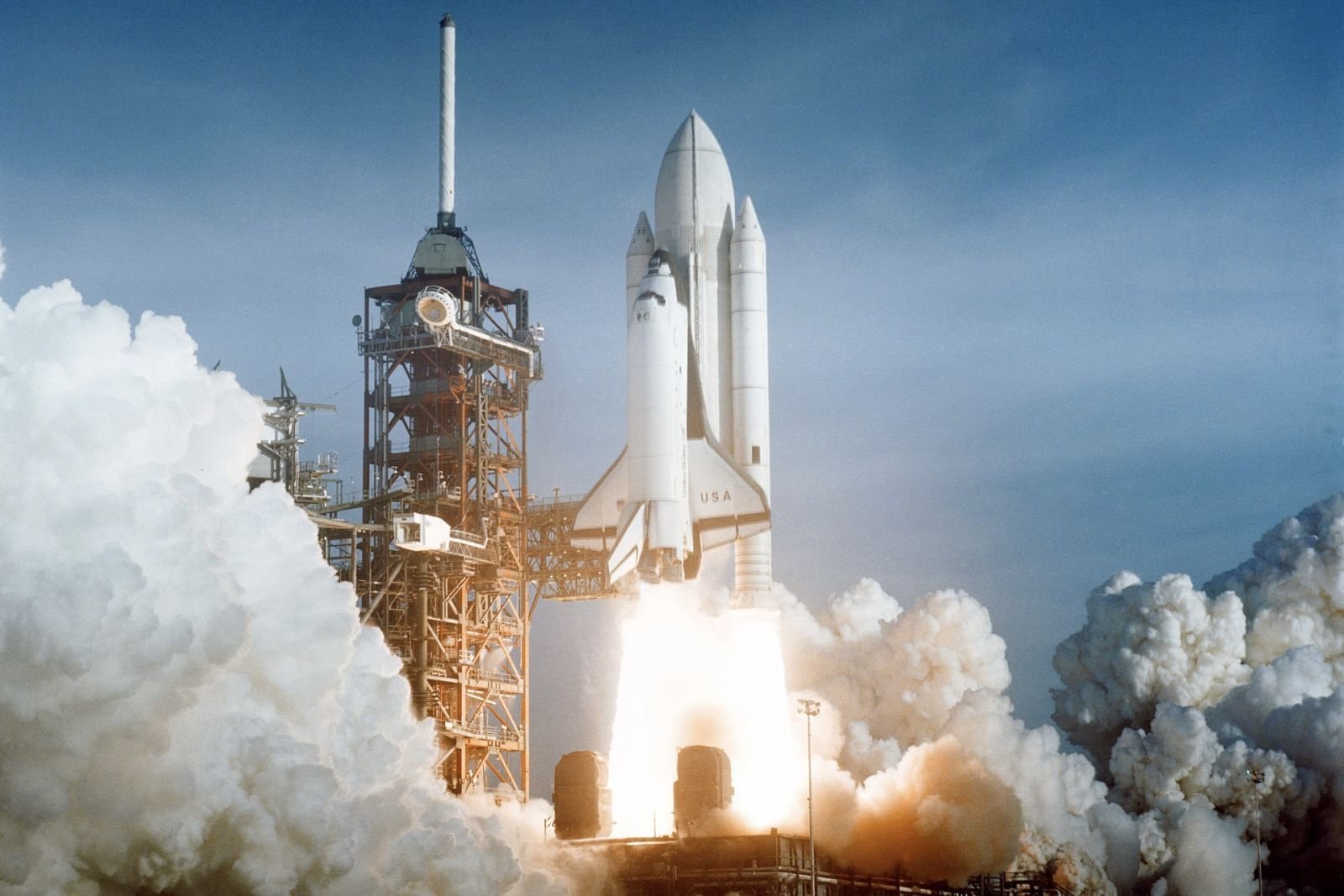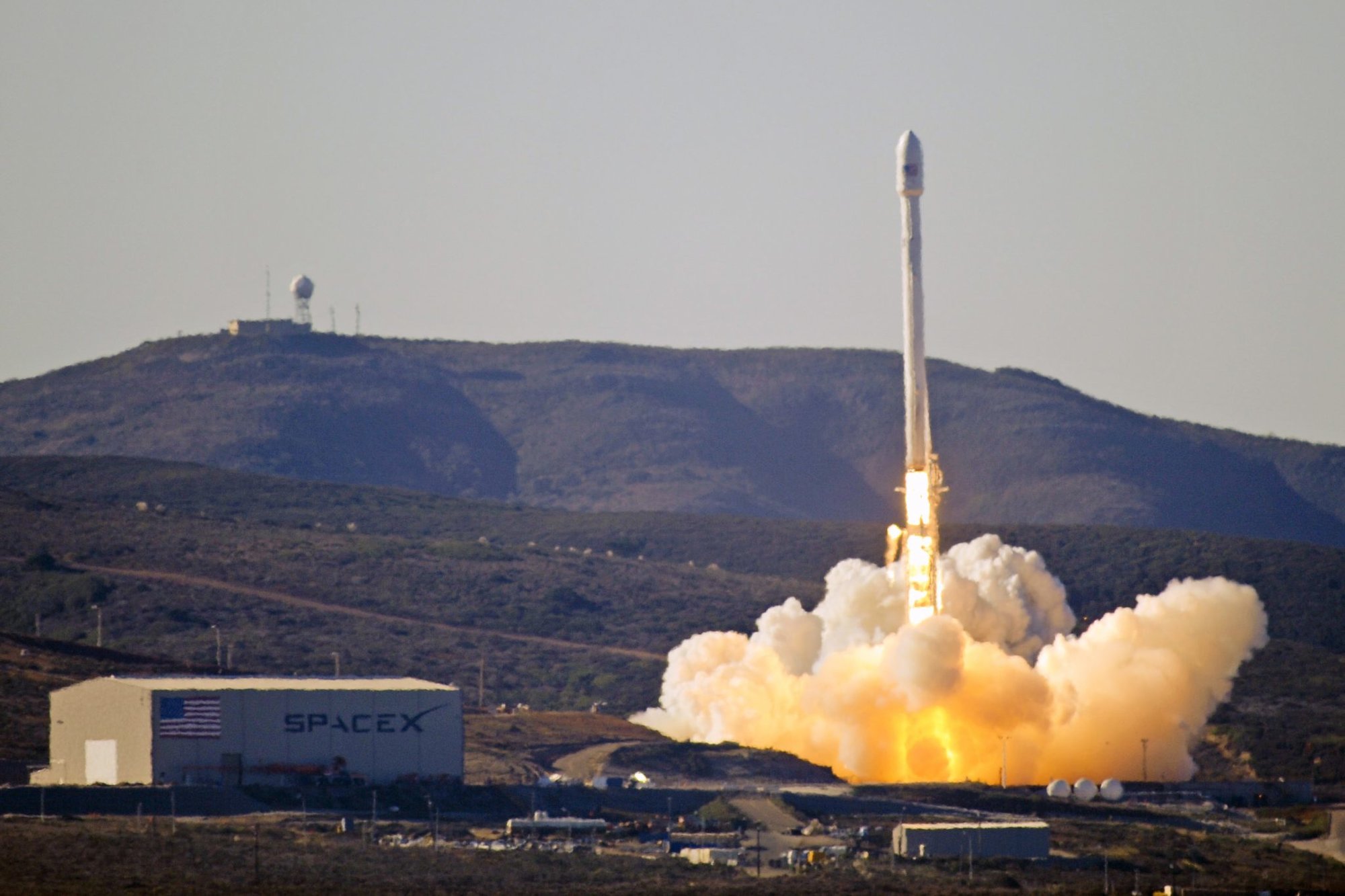
Seconds past 8 a.m. Eastern Time April 12, 1981, the space shuttle Columbia carries astronauts John Young and Robert Crippen into an Earth orbital mission scheduled to last for 54 hours, ending with an unpowered landing at Edwards Air Force Base in California. Photo courtesy of NASA.
Vandenberg Air Force Base, located nearly 150 miles northwest of Los Angeles, transitioned into the third US Space Force installation on Friday. The huge base has long been a test bed for Air Force space-focused projects, including rocket launches. But in NASA’s post-moonshot heyday, it was nearly a hub for military-only space shuttle launches.
When the space shuttle program was launched, the Air Force initially considered buying as many as three of the ships for its own use. But the dream of these so-called “Blue Shuttles” quickly gave way to a two-decade cooperation between the military and NASA, which gave the military use of NASA’s shuttles to launch classified military hardware into orbit. The secretive project was called the Manned Spaceflight Engineer Program, which involved NASA, the National Reconnaissance Office (NRO, an agency whose existence was only declassified in 1992), and the Air Force.
The program ended abruptly, with the 1986 Challenger disaster as the final blow to the project’s momentum.

Vandenberg opened in California in 1941 as the US Army’s Camp Cooke, where it served as a training ground for five armored and infantry divisions during World War II. The base was handed off to the Air Force in 1957, shortly before the Soviet Union’s successful launch of Sputnik 1, humanity’s first artificial satellite and the Cold War space race’s first significant achievement. The Air Force used the facility to conduct test firings of strategic missile weapon systems. Because of the base’s ideal position near the Pacific Ocean, the missiles avoided most civilian flight paths. When the Air Force began advancing its capabilities with ballistic missiles in 1958, it renamed the base after former Air Force chief of staff Gen. Hoyt S. Vandenberg.
A key distinction between spaceflights from Vandenberg and those launched from Florida is the kind of orbit. All launches are made over open ocean for safety. Those from Florida ascend eastward and eventually orbit in an east-to-west direction, chasing the Earth’s rotation. Vandenberg offers a flight path south over the Pacific, pushing its launches to pole-to-pole orbits. In 1959, Vandenberg Air Force Base made history, launching the world’s first polar-orbiting satellite into space and revolutionizing communication for the United States.
By the early 1960s, National Security Space (NSS) under the Department of Defense had two “military man in space” programs: the Dyna Soar space plane and the Manned Orbiting Laboratory program. The two military-astronaut missions were meant to capture surveillance photos, but both projects were scrapped because of Defense and NSS skepticism that the programs would be worth both their financial costs and the inevitable unwanted attention they would attract. When the Manned Orbiting Laboratory mission was canceled in 1969, the 14 astronaut-qualified military officers meant to fly in the program and the nearly completed Vandenberg launch facility were left without a mission.

The revival of military space programs came a decade later when the military began building a coast-to-coast organization known as the Manned Spaceflight Engineer Program. With an annual budget of about $4 million, the top-secret program trained an elite group of military astronauts selected by the NRO, then unknown to the general public, to serve as payload specialists.
The military’s relationship with NASA was rocky from the start — the two groups had different priorities. “I was naive enough to believe that the payload side would be treated by NASA the same way the Air Force launch people treated us,” Gary Payton, the only one of the first group of military astronauts to fly, told Air & Space Magazine. “In the world I came from, payload requirements would drive the time of day you launched, the time of year, everything. In 1980, NASA was still worried about getting the shuttle to fly. So we were not paid much attention to. It was a rude awakening.”
When Payton and the military’s first classified payload finally flew on STS-51-C in January 1985, launching from Kennedy Space Center in Florida, the public countdown was only announced nine minutes before liftoff.
The Air Force released only vague details, such as the successful deployment of the payload, keeping all other information behind a cloak of secrecy. The payload that Payton suggested was aboard the STS-51-C Discovery was Orion, an eavesdropping satellite for signals intelligence.

But the real moment of truth for an “Air Force Space Shuttle” was to come with a launch from Vandenberg. In February 1985, NASA and the Pentagon announced the crew of STS-62-A would prepare for liftoff from Vandenberg, but repeated delays in construction pushed the expected launch date to the summer of 1986.
On Jan. 28, 1986, the entire country witnessed the horror of the Challenger accident, in which six NASA astronauts and one high school teacher were killed 73 seconds after liftoff. The disaster marked the beginning of the end of US Air Force involvement in space shuttle payload operations.
The Challenger accident made the Air Force realize that its multibillion-dollar satellites were no safer than the shuttle itself, a realization that tipped the Air Force to launching its payloads on unmanned rockets from Vandenberg. “By 1987, it was all gone,” William J. Baugh, director of public affairs for the Air Force 2nd Space Wing at Falcon Air Force Base (now Schriever AFB) in Colorado, recalled to The New York Times in 1989. “By that time, Challenger had its problem, and we decided to get out of the shuttle business.”
From 1982 to 1992, NSS and NASA completed 11 missions without the military, and the $3.3 billion space complex at Vandenberg was left unused.
Read Next: California’s Vandenberg Becomes Third Space Force Base

Matt Fratus is a history staff writer for Coffee or Die. He prides himself on uncovering the most fascinating tales of history by sharing them through any means of engaging storytelling. He writes for his micro-blog @LateNightHistory on Instagram, where he shares the story behind the image. He is also the host of the Late Night History podcast. When not writing about history, Matt enjoys volunteering for One More Wave and rooting for Boston sports teams.
BRCC and Bad Moon Print Press team up for an exclusive, limited-edition T-shirt design!
BRCC partners with Team Room Design for an exclusive T-shirt release!
Thirty Seconds Out has partnered with BRCC for an exclusive shirt design invoking the God of Winter.
Lucas O'Hara of Grizzly Forge has teamed up with BRCC for a badass, exclusive Shirt Club T-shirt design featuring his most popular knife and tiomahawk.
Coffee or Die sits down with one of the graphic designers behind Black Rifle Coffee's signature look and vibe.
Biden will award the Medal of Honor to a Vietnam War Army helicopter pilot who risked his life to save a reconnaissance team from almost certain death.
Ever wonder how much Jack Mandaville would f*ck sh*t up if he went back in time? The American Revolution didn't even see him coming.
A nearly 200-year-old West Point time capsule that at first appeared to yield little more than dust contains hidden treasure, the US Military Academy said.












